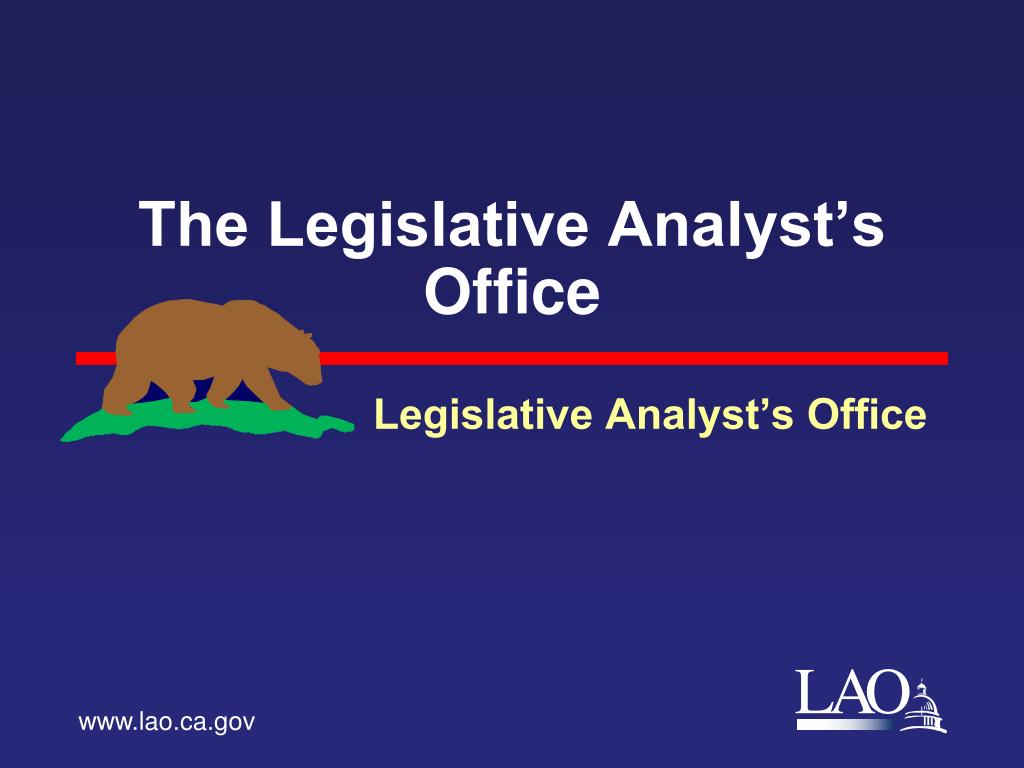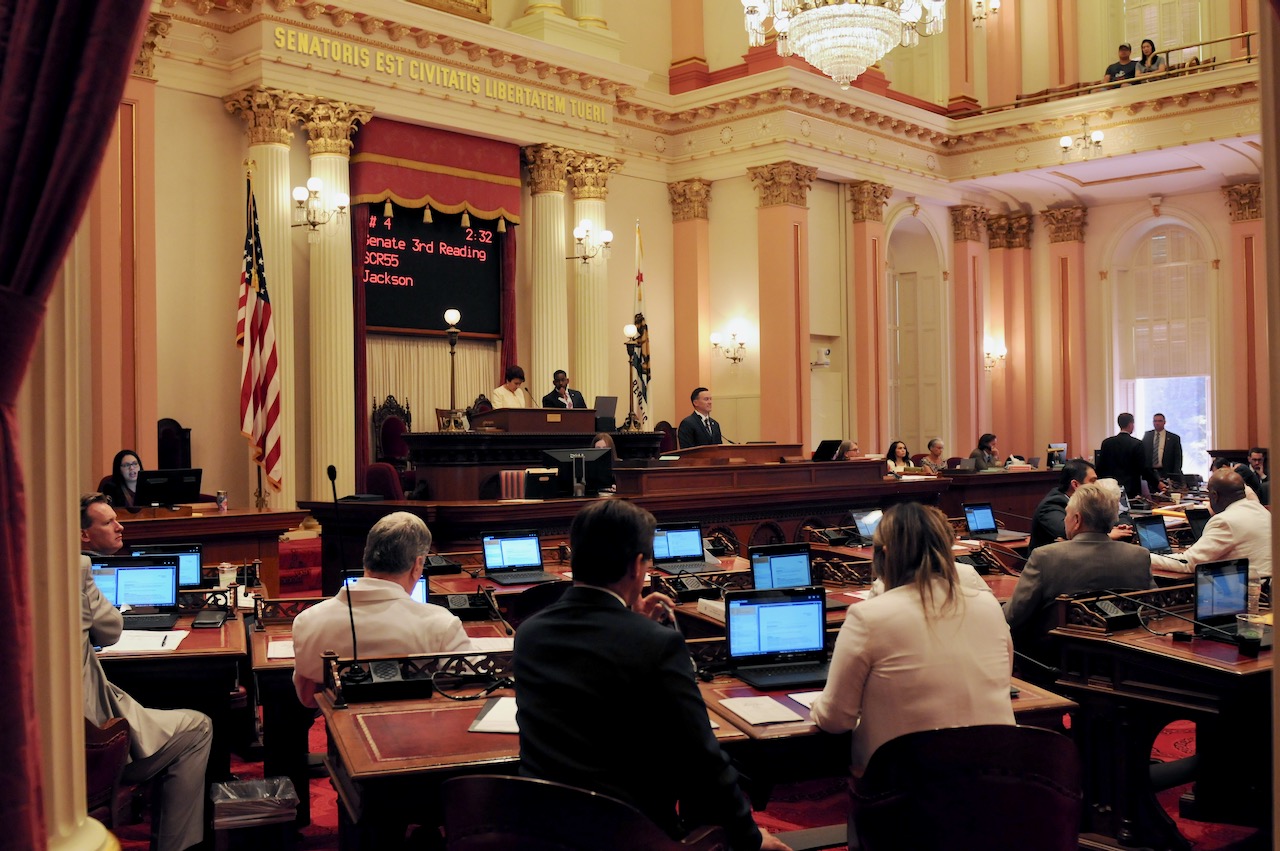
Attorney General Sign. (Photo: Kevin Sanders for California Globe)
Roles of the Attorney General and the Legislative Analyst in the Initiative Process
The courts have ruled on the initiative ballot title and summary requirements that they are to avoid misleading the public with inaccurate information
By Chris Micheli, November 29, 2019 2:04 am
In California’s initiative process, both the Attorney General and the Legislative Analyst play important roles. Those roles are established by the state Constitution, as well as the California Elections Code. This article provides an overview of the relevant laws specifying their respective roles.
Attorney General
In California Constitution’s Article II, the three forms of direct democracy, including the initiative, are found. Section 10 of Article 2 describes the role of the Attorney General. In subsection (d), it provides: “Before circulation of an initiative or referendum petition for signatures, a copy shall be submitted to the Attorney General who shall prepare a title and summary of the measure as provided by law.”
There are numerous provisions of California’s Elections Code setting forth the AG’s role. Section 9001 requires the text of the proposed measure to be submitted to the Attorney General with a written request that a circulating title and summary of the chief purpose and points of the proposed measure be prepared. The electors presenting the request are known as the “proponents.” The Attorney General has to preserve the written request until after the next general election.
Section 9001 also provides that the proponents of a proposed initiative measure, at the time of submitting the text of the proposed measure to the Attorney General, must pay a fee to the Attorney General of $2,000 that is placed in a trust fund in the office of the Treasurer and refunded to the proponents if the measure qualifies for the ballot within two years from the date the summary is furnished to the proponents. If the measure does not qualify within that period, the fee is immediately paid into the state’s General Fund.
Section 9002 specifies that, upon receipt of a request from the proponents of a proposed initiative measure for a circulating title and summary, the Attorney General must initiate a public review process for a period of 30 days by posting the text on its website and inviting and providing for written public comments.
Pursuant to Section 9002, during the public review period, the proponents of the proposed initiative measure may submit amendments to the measure that are reasonably germane to the theme, purpose, or subject of the initiative measure as originally proposed. However, amendments cannot be submitted if the initiative measure as originally proposed would not effect a substantive change in law.
Section 9003 assigns the roles of the AG, such as preparing the title and summary, to the Legislative Counsel is the AG is a proponent of a proposed measure. Section 9004 specifies that, after the public review period, the AG must prepare a circulating title and summary of the chief purposes and points of the proposed measure. The circulating title and summary cannot exceed 100 words.
The Attorney General is also responsible for providing a unique numeric identifier for each proposed initiative measure. The circulating title and summary must be prepared in the manner provided for the preparation of ballot titles and summaries in the Elections Code. Also pursuant to Section 9004, the AG provides a copy of the title and summary and identifier to the proponents and the Secretary of State after receiving the fiscal estimate.
Section 9005 sets forth details about the contents of the title and summary, such as either the estimate of the amount of any increase or decrease in revenues or costs to the state or local government, or an opinion as to whether or not a substantial net change in state or local finances would result if the proposed initiative is adopted. The fiscal estimate is made jointly by the Department of Finance and the Legislative Analyst.
The estimate is delivered to the Attorney General within 50 days of the date of receipt of the proposed initiative measure by the Attorney General, unless, in the opinion of both the Department of Finance and the Legislative Analyst, a reasonable estimate of the net impact of the proposed initiative measure cannot be prepared within the 50-day period.
Section 9006 specifies that the Attorney General shall prepare a circulating title and summary of the chief purpose and points of the proposed statute at issue. The circulating title and summary cannot exceed a total of 100 words and the fiscal analysis is not included. Then the AG provides a copy of the title and summary to the proponents and the Secretary of State within 10 days, and the SOS notifies the proponents and county elections official of each county of the official summary date and provides a copy of the circulating title and summary to each county elections official.
Under Section 9007, the AG also has to provide the title and summary to the Assembly and Senate. Thereafter, the appropriate committees of each house may hold public hearings on the subject of the measure. However, nothing in this section is to be construed as authority for the Legislature to alter the measure or prevent it from appearing on the ballot.
Section 9008 requires that every proposed initiative, prior to its circulation for signatures, must have placed across the top of the petition in 12-point or larger roman boldface type, all of the following: AG’s unique numeric identifier, title and summary upon each page of the petition for signature gathering and preceding the text of the measure.
Pursuant to Section 9050, after the Secretary of State determines that a measure will appear on the ballot at the next statewide election, the Secretary of State must promptly transmit a copy of the measure to the Attorney General. The Attorney General then provides and returns to the Secretary of State a ballot title and summary and ballot label for each measure submitted to the voters of the whole state by a date sufficient to meet the state voter information guide public display deadlines.
The courts have examined the role of the AG. The Attorney General complied with the mandate that he provide the electorate with “a true and impartial statement of the purpose of the measure” by essentially repeating the operative language of the ballot initiative measure. The mandate to the Attorney General in preparing the official summary of the voters’ initiative measure is to state the purpose and effect of the measure, not to reiterate selectively fragments of public commentary and debate on the measure. Lungren v. Superior Court (1996) 48 Cal.App.4th 435
The courts have also ruled on the main purpose of the pre-election initiative ballot title and summary requirements that they are to avoid misleading the public with inaccurate information. In ruling on a challenge to the sufficiency of the ballot initiative title and summary, the courts are not vested with a wide range of discretion; relief may be granted only upon clear and convincing proof that the challenged ballot materials in question are false, misleading or inconsistent with the requirements of the Elections Code.
A difference of opinion does not rise to the level of clear and convincing proof that the challenged language in a ballot initiative title and summary and the ballot label is misleading. If reasonable minds may differ as to its sufficiency, the ballot initiative title and summary prepared by the Attorney General must be upheld, because all legitimate presumptions should be indulged in favor of the propriety of the Attorney General’s actions; only in a clear case should a title and summary so prepared be held insufficient. Yes on 25, Citizens for an On-Time Budget v. Superior Court (2010) 189 Cal. App.4th 1445
Legislative Analyst
Section 9005 requires the AG to include in the title and summary for a proposed initiative measure either the estimate of the amount of any increase or decrease in revenues or costs to the state or local government, or an opinion as to whether or not a substantial net change in state or local finances would result if the proposed initiative is adopted.
The estimate is to be made jointly by the Department of Finance and the Legislative Analyst. The estimate must be delivered to the Attorney General within 50 days of the date of receipt of the proposed initiative measure by the Attorney General. A statement of fiscal impact prepared by the Legislative Analyst may be used by the Department of Finance and the Legislative Analyst in the preparation of the fiscal estimate or the opinion.
Pursuant to Section 9051, the ballot title and summary must include a summary of the Legislative Analyst’s estimate of the net state and local government fiscal impact. Section 9085 requires the state voter information guide to contain a section, which is located near the front of the guide, to provide a concise summary of the general meaning and effect of “yes” and “no” votes on each state measure.
The summary statements required under this section must be prepared by the Legislative Analyst. The Analyst is solely responsible for determining the contents of these statements and they are to be made available for public examination and amendment.
Section 9087 requires the Legislative Analyst to prepare an impartial analysis of the proposed initiative measure describing the measure and including a fiscal analysis of the measure showing the amount of any increase or decrease in revenue or cost to state or local government. If it is estimated that a measure would result in increased cost to the state, an analysis of the measure’s estimated impact on the state shall be provided, including an estimate of the percentage of the General Fund that would be expended due to the measure, using visual aids when appropriate. An estimate of increased cost to the state or local governments shall be set out in boldface print in the state voter information guide.
Section 9087 also provides that, to the extent practicable, the Legislative Analyst shall use a uniform method in each analysis to describe the estimated increase or decrease in revenue or cost of a measure, so that the average voter may draw comparisons among the fiscal impacts of measures. The condensed statement of the fiscal impact summary for the measure prepared by the Attorney General to appear on the ballot shall contain the uniform estimate of increase or decrease in revenue or cost of the measure prepared pursuant to this subdivision.
In addition, the Legislative Analyst may contract with a professional writer, educational specialist, or another person for assistance in writing an analysis that fulfills the requirements of this section, including the requirement that the analysis be written so that it will be easily understood by the average voter. The Legislative Analyst may also request the assistance of a state department, agency, or official in preparing his or her analysis.
Finally, under Section 9087, before submitting the analysis to the Secretary of State, the Legislative Analyst is required to submit the analysis to a committee of five persons, appointed by the Legislative Analyst, for the purpose of reviewing the analysis to confirm its clarity and easy comprehension to the average voter. The Legislative Analyst must consider the committee’s recommendations, and he or she shall incorporate in the analysis those changes recommended by the committee that he or she deems to be appropriate. The Legislative Analyst is solely responsible for determining the content of the analysis required by this section.
Section 9088 specifies that, at each statewide election at which state bond measures will be submitted to the voters for their approval or rejection, the state voter information guide for that election must include a discussion that is prepared by the Legislative Analyst concerning the state’s current bonded indebtedness situation.
There have been some court cases regarding the role of the Legislative Analyst. An appellate court determined that the preparer of a ballot pamphlet summarizing the meaning and effect of a ballot measure necessarily exercises a discretionary function requiring courts to allow considerable latitude when the result is challenged as incomplete or inaccurate. The Legislative Analyst, in preparing the ballot pamphlet, is called upon only to make a rational judgment about what effects are most likely to matter to voters, and to describe them in a fair and intelligible way. People v. Cordova (2016) 248 Cal.App.4th 543
- Minors Enlisting in the Armed Forces - July 28, 2025
- Remote Marriage Licenses in California - July 27, 2025
- Legislative Policy on Bay Area Pilotage - July 26, 2025








I thought the role of the CA Attorney General was to be the Governor’s personal attack dog, and to reflexively file lawsuits in response to every one of the President’s tweets….